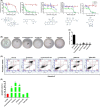Identification of natural compounds tubercidin and lycorine HCl against small-cell lung cancer and BCAT1 as a therapeutic target
- PMID: 35318805
- PMCID: PMC9077304
- DOI: 10.1111/jcmm.17246
Identification of natural compounds tubercidin and lycorine HCl against small-cell lung cancer and BCAT1 as a therapeutic target
Abstract
Although small-cell lung cancer (SCLC) accounts for a small fraction of lung cancer cases (~15%), the prognosis of patients with SCLC is poor with an average overall survival period of a few months without treatment. Current treatments include standard chemotherapy, which has minimal efficacy and a newly developed immunotherapy that thus far, benefits a limited number of patients. In the current study, we screened a natural product library and identified 5 natural compounds, in particular tubercidin and lycorine HCl, that display prominent anti-SCLC activities in vitro and in vivo. Subsequent RNA-sequencing and functional validation assays revealed the anti-SCLC mechanisms of these new compounds, and further identified new cellular factors such as BCAT1 as a potential therapeutic target with clinical implication in SCLC patients. Taken together, our study provides promising new directions for fighting this aggressive lung cancer.
Keywords: BCAT1; SCLC; drug screening; lung cancer; natural product.
© 2022 The Authors. Journal of Cellular and Molecular Medicine published by Foundation for Cellular and Molecular Medicine and John Wiley & Sons Ltd.
Conflict of interest statement
All the authors declare no competing interests.
Figures






Similar articles
-
The landscape of immune checkpoint inhibitor therapy in advanced lung cancer.BMC Cancer. 2021 Aug 28;21(1):968. doi: 10.1186/s12885-021-08662-2. BMC Cancer. 2021. PMID: 34454455 Free PMC article.
-
[New Advances in the Treatment for Small Cell Lung Cancer].Zhongguo Fei Ai Za Zhi. 2019 Jun 20;22(6):355-362. doi: 10.3779/j.issn.1009-3419.2019.06.05. Zhongguo Fei Ai Za Zhi. 2019. PMID: 31196369 Free PMC article. Review. Chinese.
-
Systemic Therapy of Extensive Stage Small Cell Lung Cancer in the Era of Immunotherapy.Curr Treat Options Oncol. 2020 Jun 29;21(8):64. doi: 10.1007/s11864-020-00762-8. Curr Treat Options Oncol. 2020. PMID: 32601742 Review.
-
m6A regulator expression profile predicts the prognosis, benefit of adjuvant chemotherapy, and response to anti-PD-1 immunotherapy in patients with small-cell lung cancer.BMC Med. 2021 Nov 22;19(1):284. doi: 10.1186/s12916-021-02148-5. BMC Med. 2021. PMID: 34802443 Free PMC article.
-
The efficiency and safety of immune checkpoint inhibitors in the treatment of small cell lung cancer: a meta-analysis.Ann Palliat Med. 2020 Nov;9(6):4081-4088. doi: 10.21037/apm-20-2011. Ann Palliat Med. 2020. PMID: 33302668
Cited by
-
Cepharanthine as an effective small cell lung cancer inhibitor: integrated insights from network pharmacology, RNA sequencing, and experimental validation.Front Pharmacol. 2024 Nov 28;15:1517386. doi: 10.3389/fphar.2024.1517386. eCollection 2024. Front Pharmacol. 2024. PMID: 39669201 Free PMC article.
-
Tubercidin enhances apoptosis in serum-starved and hypoxic mouse cardiomyocytes by inducing nuclear speckle condensation.BMC Cardiovasc Disord. 2025 Mar 22;25(1):211. doi: 10.1186/s12872-025-04661-4. BMC Cardiovasc Disord. 2025. PMID: 40121465 Free PMC article.
-
Bioactive Microbial Metabolites in Cancer Therapeutics: Mining, Repurposing, and Their Molecular Targets.Curr Microbiol. 2022 Aug 24;79(10):300. doi: 10.1007/s00284-022-02990-7. Curr Microbiol. 2022. PMID: 36002695 Review.
-
Tubercidin inhibits PRRSV replication via RIG-I/NF-κB pathways and interrupting viral nsp2 synthesis.Microbiol Spectr. 2024 Mar 5;12(3):e0347923. doi: 10.1128/spectrum.03479-23. Epub 2024 Feb 1. Microbiol Spectr. 2024. PMID: 38299833 Free PMC article.
-
Branched-chain amino acid transaminase 1 confers EGFR-TKI resistance through epigenetic glycolytic activation.Signal Transduct Target Ther. 2024 Aug 15;9(1):216. doi: 10.1038/s41392-024-01928-8. Signal Transduct Target Ther. 2024. PMID: 39143065 Free PMC article.
References
-
- Cullen JK, Simmons JL, Parsons PG, Boyle GM. Topical treatments for skin cancer. Adv Drug Deliv Rev. 2019;153:54‐64. - PubMed
Publication types
MeSH terms
Substances
Grants and funding
LinkOut - more resources
Full Text Sources
Medical

